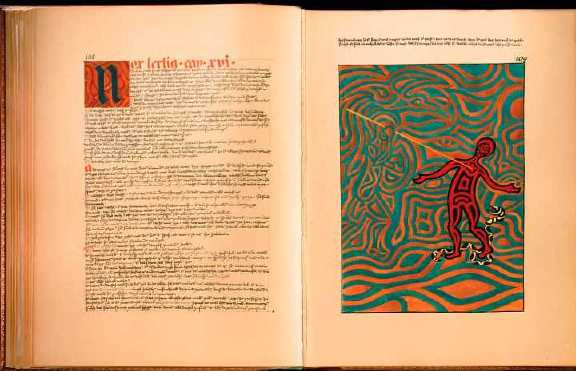
Sara Corbett, writing in the Sunday New York Times Magazines, tells the story of the publication of Carl Jung’s most prominent, heretofore unpublished, work, The Red Book. The Holy Grail of the Unconscious
Seeing the article trumpeted on the magazine’s front page, then slowly taking in photos of several two page layouts, and then, finally, reading the article carefully, made for an unanticipated pleasure on a Sunday afternoon.
Although the story is a good one, here I’ll highlight the author’s summary of part of Dr. Jung’s long (1975-1961) life.
Carl Jung founded the field of analytical psychology and, along with Sigmund Freud, was responsible for popularizing the idea that a person’s interior life merited not just attention but dedicated exploration — a notion that has since propelled tens of millions of people into psychotherapy. Freud, who started as Jung’s mentor and later became his rival, generally viewed the unconscious mind as a warehouse for repressed desires, which could then be codified and pathologized and treated. Jung, over time, came to see the psyche as an inherently more spiritual and fluid place, an ocean that could be fished for enlightenment and healing.
Whether or not he would have wanted it this way, Jung — who regarded himself as a scientist — is today remembered more as a countercultural icon, a proponent of spirituality outside religion and the ultimate champion of dreamers and seekers everywhere, which has earned him both posthumous respect and posthumous ridicule. Jung’s ideas laid the foundation for the widely used Myers-Briggs personality test and influenced the creation of Alcoholics Anonymous. His central tenets — the existence of a collective unconscious and the power of archetypes — have seeped into the larger domain of New Age thinking while remaining more at the fringes of mainstream psychology.
A big man with wire-rimmed glasses, a booming laugh and a penchant for the experimental, Jung was interested in the psychological aspects of séances, of astrology, of witchcraft. He could be jocular and also impatient. He was a dynamic speaker, an empathic listener. He had a famously magnetic appeal with women. Working at Zurich’s Burghölzli psychiatric hospital, Jung listened intently to the ravings of schizophrenics, believing they held clues to both personal and universal truths. At home, in his spare time, he pored over Dante, Goethe, Swedenborg and Nietzsche. He began to study mythology and world cultures, applying what he learned to the live feed from the unconscious — claiming that dreams offered a rich and symbolic narrative coming from the depths of the psyche. Somewhere along the way, he started to view the human soul — not just the mind and the body — as requiring specific care and development, an idea that pushed him into a province long occupied by poets and priests but not so much by medical doctors and empirical scientists.
That’s a fairly good recap.

“Venus” figurine. Est. 35,000 years old.
I’m looking forward to receiving another visitation from Dr. Jung.
Continue reading
